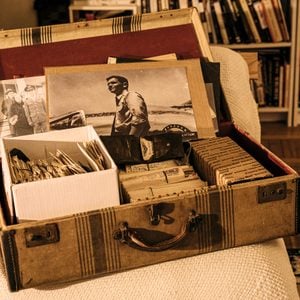Women of Ukraine Fight Back: How They’re Revolutionizing the Role of Women in War
Updated: Apr. 06, 2023
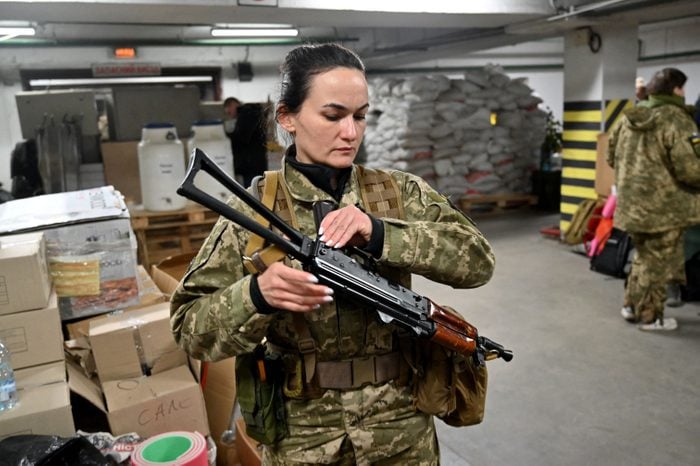
The Ukrainian women who opted to stay in the country during the Russian invasion have taken on a variety of crucial roles in the resistance—including participating in combat.
Several weeks into Russia’s unprovoked invasion of Ukraine, Kyiv resident Olga Limarenko went to her local branch of Ukraine’s territorial defense force to volunteer for military service. But she wasn’t the only person with that idea and ended up being turned away. “They said, ‘OK, you will be in a line,'” she told NPR in a recent interview. “‘But now we have too many people.'”
Undeterred, the 36-year-old architect relocated to Lviv, where she has been making Molotov cocktails that will be sent to Ukrainian cities under Russian occupation. “During the last week, we made about 1,000 of them,” Limarenko explained.
And like so many other Ukrainian women—including current members of the military, as well as civilian volunteers like herself—she’s not afraid to participate in combat if that time comes. “We are not weak,” Limarenko said. “We are just waiting.”
Limarenko’s story is just one of many coming out of Ukraine since Russian forces launched early morning rocket attacks and began shelling a number of Ukrainian cities—including the country’s capital, Kyiv—on February 24, 2022. Ukrainian female soldiers have been fighting on the front lines since Russia first invaded Ukraine in 2014, but the recent military action has prompted more women to actively defend their country, including by joining civilian resistance groups. Some of these women have never held a rifle before, let alone fired one.
While much of the world figures out how to help Ukraine and President Volodymr Zelensky right now, as well as how to assist and protect the 3.6 million Ukrainian refugees who have fled the country, the women remaining in cities like Kyiv, Lviv, and Kharkiv, as well as the largely rural center of the country, are now participating in every aspect of the war. That includes taking up arms to defend themselves, their families, and Ukraine’s freedom.
Why did Ukrainian women join the front lines in the current war?
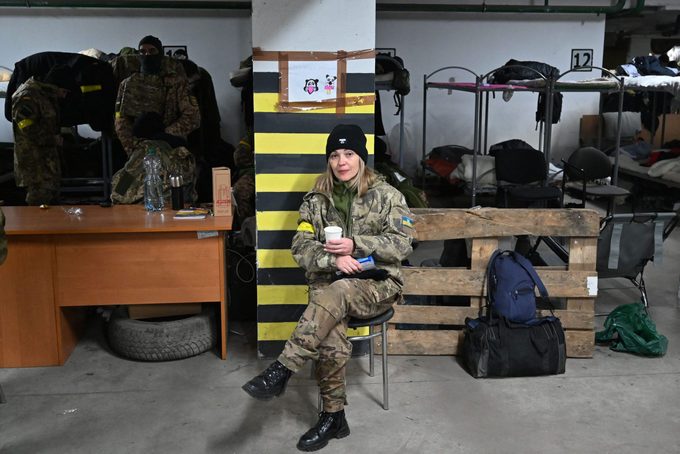
Ukrainian women are no strangers to military service and combat activities. In fact, Ukrainian female soldiers have actively participated in armed combat for nearly a century, including serving as officers in the Austro-Hungarian army during World War I and the Red Army in World War II. But to understand women’s involvement in the current resistance to Russia’s invasion, it’s necessary to look back at the history of the conflict, says Olena Nikolayenko, PhD, a professor of political science at Fordham University and an associate at the Davis Center for Russian and Eurasian Studies at Harvard University.
“In 2013, then-President of Ukraine Viktor Yanukovych was supposed to sign an association agreement with the European Union, to liberalize trade and deepen Ukraine’s ties with the European Union,” Nikolayenko tells Reader’s Digest. “But at the last moment, he abruptly changed his opinion and declined to sign that agreement, which caused public outrage.” As a result, thousands of Ukrainians took to the streets and protested, occupying Independence Square in Kyiv.
This marked a turning point for women in Ukraine, in terms of their participation in armed conflict, according to Sarah D. Phillips, PhD, a professor of anthropology and the director of the Robert F. Byrnes Russian and East European Institute at Indiana University. “Women were active in every sphere of the protests, including being on the barricades, leading teach-ins and workshops, getting trained in self-defense, and volunteering to support a range of efforts to provide humanitarian support and protection for vulnerable citizens,” she explains. “Women were very clear that they did not want to be relegated to making soup and sandwiches for the protesters; they wanted to actively participate in every facet of the Revolution of Dignity.”
The 2014 standoff between the government and protesters lasted approximately three months. Soon after that, Yanukovych was removed from office, and Russian troops moved into Crimea and eastern Ukraine. “A significant number of women who were involved in this protest movement then chose to join volunteer battalions in eastern Ukraine and continue to fight against Russia’s aggression,” says Nikolayenko. “When the level of violence subsided, many of them tried to return back to civilian life.”
And now, eight years later, the escalation of Russia’s aggression against Ukraine has prompted some of these women to fight again, Nikolayenko explains, adding that “it’s not surprising that they are in field combat positions.”
How many Ukrainian women are involved in combat?
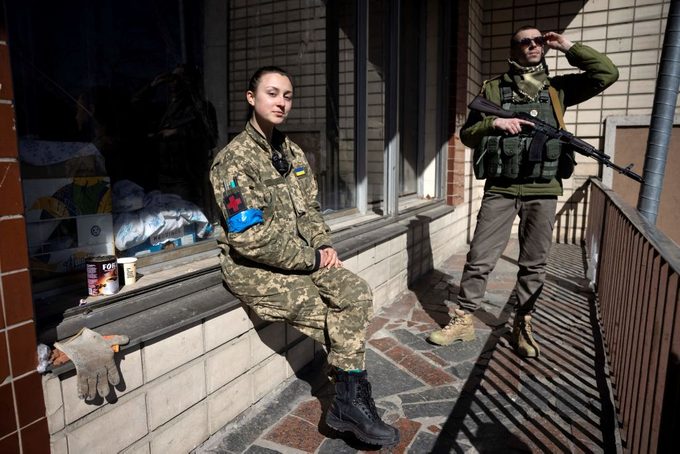
Though the precise number of women in the Ukrainian military in March 2022 is not yet known, at this time last year, 31,757 women made up 15.6 percent of the Armed Forces of Ukraine, according to a 2021 report from ArmyInform, an information agency for the Ministry of Defense of Ukraine. And according to Victoria Arnautova, an adviser to the Commander-in-Chief of the Armed Forces of Ukraine, roughly 13,000 of those women were combatants—and more than 900 of them were officers in command positions.
Officially, women have only been permitted to take on these combat roles in the Ukrainian military since 2016. “Prior to that point, even those women who were willing to serve in the military on a contractual basis were limited in the range of positions that they could take up in the Ukrainian army,” says Nikolayenko. “Although at times they might, in reality, have taken on roles with greater responsibilities.”
And as far as statistics go, it’s important to keep in mind that not all women currently participating in combat are members of the military. “There’s so [many] more women in resistance groups who will be able to fight Russians as well as the men do,” Kira Rudik, a member of both the Ukrainian Parliament and a civilian resistance group, told CNN in February. “I think the numbers are actually higher, in terms of women fighting right now in the army and fighting Russians everywhere they can.”
Can Ukrainian women be drafted?
While Ukrainian women aren’t required to serve in the military, a new law took effect in December 2021 stipulating that women between the ages of 18 and 60 and working in one of 100 professions must register with their local branch of the Ministry of Defense for potential military service. A few examples of occupations on the list include doctors, bank employees, journalists, and restaurant staff, the Kyiv Independent reported at the end of last year.
“When that law was passed, it was a way of taking stock of the number of women who possess certain occupational skills and are in good health, and who could be recruited to serve in the military in case of a war,” Nikolayenko explains. “It doesn’t mean that under normal circumstances they would have to serve in the armed forces.”
More Stories About the War in Ukraine
|
Meet some of the Ukrainian female soldiers defending their country
Though there are countless examples of women demonstrating strength and courage during the ongoing Ukraine-Russia war both in and out of the military, here are a few stories of Ukrainian female soldiers fighting on the front lines.
Kira Rudik
Good extract from @CNBCnow pic.twitter.com/PG8dqjjHvi
— Kira Rudik (@kiraincongress) March 15, 2022
On the first day of Russian airstrikes on Ukraine in February 2022, Kira Rudik, a 36-year-old member of the Ukrainian Parliament, met with other members of her party in Kyiv to figure out what to do next. Collectively, they determined that moving forward, they should do whatever was most beneficial for Ukraine. For her, that meant staying in the capital and joining the civilian resistance.
“I’m the most useful here, where I can bear arms and I can motivate others to do the same,” Rudik told CNN on March 9. “I can make sure that Putin has much more people to fight than he originally thought that he would have, because along with Ukrainian men, there are women who are standing up, bearing arms, and adding to these numbers.”
Prior to this point, Rudik had no experience with firearms, but over the past few weeks, she has learned how to load and shoot a variety of different rifles. During this time, she has also been participating in government, giving countless interviews to media outlets around the world, and documenting her experience on social media.
Sergeant Inna Derusova
Sergeant Inna Derusova, a 52-year-old senior combat medic, was making her way back from vacation when Russian forces launched airstrikes in Ukraine on February 24, 2022. She spent the next two days tending to those wounded in the attacks on the city of Okhtyrka, located about 350 miles from Kyiv.
Derusova worked until February 26, when she was killed during a Russian shelling attack. On March 12, she became the first woman to be awarded the title of “Hero of Ukraine” posthumously.
Yana Zinkevych
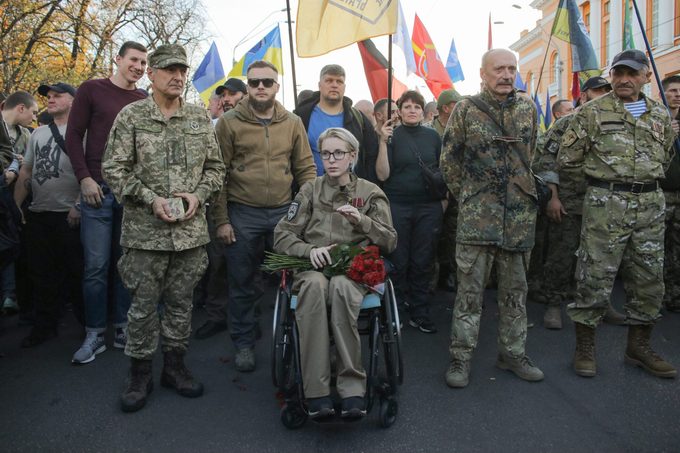
When the armed conflict in the Donbas region of Ukraine broke out in March 2014, immediately following the violent protests in Kyiv, 19-year-old medical student Yana Zinkevych decided to provide first aid to Ukrainian soldiers fighting on the front lines. Now, eight years later, Zinkevych serves as the leader and commander of the Hospitallers, as well as the chief medical officer of the Ukrainian Volunteer Army and, as of 2019, a member of the Ukrainian Parliament.
Unfortunately, the military veteran’s participation on the front lines has been limited since she sustained serious injuries in a 2015 car accident. But the Hospitallers have continued to provide care to those wounded in conflict, as well as training for people who would like to volunteer as paramedics, including during the ongoing airstrikes and invasions.
Sofia and Solomia Artemchuk
When 30-year-old twins Sofia and Solomia Artemchuk recently joined the Hospitallers, they didn’t realize that their mother had done something similar seven years prior. “We did not even know that our mother had volunteered when she did—she did not want to worry us,” Solomia told the Independent. “So maybe serving the country is part of our DNA. This is a struggle for all Ukrainians, women as well as men. It is natural that we would want to take part in this.”
The twins are stationed at one of the Hospitallers’ bases in Kyiv, where they provide emergency medical care for the wounded and assist in their evacuation from the city. And like the rest of their battalion, the Artemchuk sisters are armed. “We knew what’s involved, what the dangers are, when we joined, so we cannot complain about that,” Sofia told the Independent. “We have received training on weapons, but haven’t had to use them so far. Our job is to save lives, that is our priority, but we have to defend ourselves as well, if necessary.”
How women’s participation has changed Ukraine’s military and culture
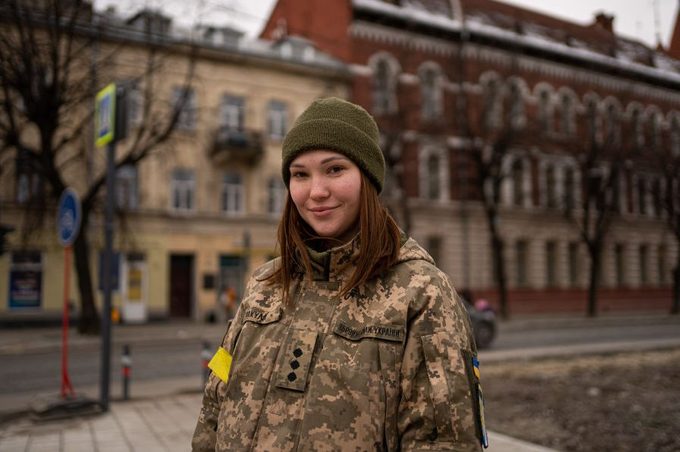
When violence in eastern Ukraine broke out in 2014, some members of the country’s armed forces had reservations about women’s participation in conflict, Nikolayenko says. As a result, many women opted to join volunteer battalions that cooperated with the armed forces instead. According to Nikolayenko, these battalions “were more loosely organized and more receptive to recruits with diverse backgrounds” than the Ukrainian military.
But as the war progressed and women fought in those battalions—proving their strength and physical stamina, as well as demonstrating their wide range of skills—Nikolayenko says that they gradually earned the respect of male soldiers, prompting greater gender integration into the Ukrainian military. This, in turn, began to change attitudes within the armed forces and Ukrainian society as a whole.
“Whenever there is some sort of crisis, or war, or conflict, it creates, to some extent, an opportunity for women to carve out more space for themselves and contest the dominant gender norms,” Nikolayenko explains. “And I think that’s in part what happened in Ukraine, when Russia annexed Crimea and then occupied parts of eastern Ukraine. Since 2014, women have been much more actively involved in the armed forces—volunteering to serve in the Ukrainian army on a contractual basis and assuming more combat positions.”
Other ways Ukrainian women are contributing to the war effort
With all the global media attention Ukrainian female soldiers have been receiving for participating in the war, it’s essential to remember that women in Ukraine (or anywhere in the world, for that matter) should not be lumped together with the assumption that they all share the same goals, interests, and motivations. “Ukrainian women are not a monolithic block,” says Bénédicte Santoire, a doctoral student in political science at the University of Ottawa whose research focuses on women, peace, and security in post-Soviet states, including Ukraine. “There are women from different ethnic communities—for example, Roma women and Afro-Ukrainians—there are poor women, disabled women, elderly women, [and] queer women, among others.”
Along the same lines, there are myriad ways that women in Ukraine are demonstrating strength and courage that don’t involve picking up a rifle or making Molotov cocktails. “In paying attention to Ukrainian women in the military, one should not lose sight of the courageous actions of women in other aspects of Ukrainian society,” Santoire notes. “Ukrainian women are involved in all spheres of civil society: in political institutions, in the army, in the media, in volunteer battalions, and in field operations—for example, working as doctors and nurses in hospitals or for humanitarian nongovernmental organizations.”
Women demonstrating strength and courage during times of war is nothing new. And thanks to the visibility of Ukrainian women and their wide-ranging contributions to the ongoing war, the world is getting another reminder of that.
Next, read what is a war crime and how are war criminals prosecuted.
Sources:
- NPR: “Ukrainian women are volunteering to fight — and history shows they always have”
- Olena Nikolayenko, PhD, a professor of political science at Fordham University and an associate at the Davis Center for Russian and Eurasian Studies at Harvard University
- Sarah D. Phillips, PhD, a professor of anthropology and the director of the Robert F. Byrnes Russian and East European Institute at Indiana University
- Ukrinform: “Number of servicewomen in Ukraine almost doubles over seven years”
- Kyiv Independent: “Explained: New requirement for Ukrainian women to register for possible military, civil defense service”
- CNN: “These are the women choosing to stay and fight Russian forces”
- Kyiv Post: “Yana Zinkevych: She nearly loses her life saving soldiers, but her fighting spirit refuses to give up”
- Independent: “Sister Act: The twins who have volunteered to work at a Kyiv medical battalion”
- Bénédicte Santoire, a doctoral student in political science at the University of Ottawa

